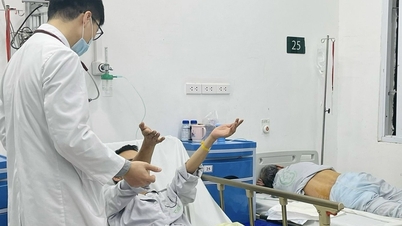Faced with declining birth rates, rapidly aging population and gender imbalance, the Ministry of Health has proposed many solutions.
Faced with declining birth rates, rapidly aging population and gender imbalance, the Ministry of Health has proposed many solutions.
According to the Ministry of Health, the national fertility rate has decreased from 2.11 children/woman (2021) to 2.01 children/woman (2022), 1.96 children/woman (2023) and 1.91 children/woman (2024) - the lowest level in history.
According to forecasts, if the birth rate continues to decrease, Vietnam will end its golden population period in 2039, the working-age population will peak in 2042 and after 2054, the population will begin to decline.
The consequences of a prolonged low fertility rate can lead to a shortage of labor force, a decline in population size, an increase in population aging and negative impacts on socio -economic development.
Over the past two decades, urban fertility has fallen below replacement level, hovering around 1.7 - 1.8 children per woman. Rural fertility remains higher, remaining at 2.2 - 2.3 children per woman.
However, by 2023, the fertility rate in rural areas will have fallen to 2.07 children per woman, below replacement level and the lowest level ever. This reflects an ongoing trend of declining fertility in both regions, signaling major challenges for future population policy.
Mr. Le Thanh Dung, Director of the Department of Population (Ministry of Health) said that the Ministry is reviewing population policies and preparing a report on the current situation and trends of birth rates in Vietnam.
The draft amendment to the Population Ordinance proposes that couples and individuals have the right to decide on the number of children, the time of birth and the spacing between births. The Ministry of Health believes that many current regulations are no longer consistent with the Constitution and the real situation.
This adjustment is aimed at maintaining the replacement level of fertility, minimizing the risk of labor shortages and population aging. In addition, the Ministry of Health also proposed to increase financial support measures, improve maternity leave, child support and other incentives to encourage families to have more children, especially in urban areas.
Vietnam is entering a golden population period with a young and abundant workforce, but the aging population is increasing. The number of people aged 60 and over currently accounts for 12% of the population. This figure is forecast to exceed 20% by 2035. This rapid change creates a burden on the social security system and health care resources.
According to some experts, to cope with the declining birth rate and aging population, Vietnam needs to focus on improving the quality of human resources. Vocational training and education programs need to be improved to meet the needs of the future labor market. Skills training for workers will help them adapt to new occupations, especially when industries change rapidly due to the development of technology and automation.
Population aging is one of the major challenges for Vietnam in the coming decades. This means that it is necessary to build a social security and health care system for the elderly. Policies to support elderly care, improve pensions and health services for the elderly are essential to reduce pressure on families and ensure sustainable development.
One of the factors that prevents many couples from having children is fertility issues. Improving assisted reproductive services, such as in vitro fertilization and infertility treatments, would help couples with fertility difficulties achieve their dream of parenthood. Insurance policies for these treatments and financial assistance for infertile couples should be a priority.
In addition, some experts say Vietnam needs a long-term strategy to improve the quality of human resources, improve the education and vocational training system, and implement support policies such as flexible labor, longer maternity leave, and financial support for young families.
In addition to adjusting fertility policies, other countries have also implemented measures such as tax subsidies, childcare support and increased in vitro fertilization services. Vietnam can refer to these models to help maintain fertility and support families in raising children.
Source: https://baodautu.vn/giai-phap-cap-bach-voi-muc-sinh-giam-d251269.html




































































































Comment (0)